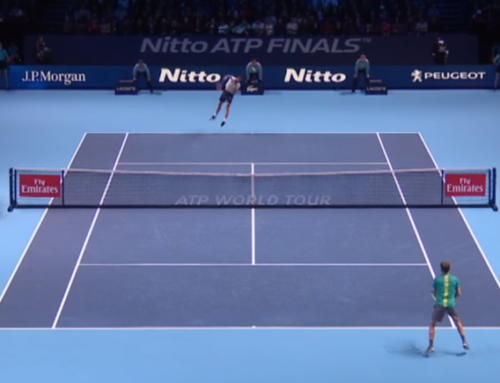In part 1 we looked at the importance of the cross-court ball for consistency in points. In today’s article we are going to look at the danger of change, and how understanding those dangers can help us reduce our errors and hence improve our chances of winning. This will be a slightly shorter article, but it lays some important groundwork for some of the more complicated things to come. Change is a very alluring thing in a tennis match. Most people are drawn to change like moths to a flame – be it change within the match, a point or even on the scale of a single stroke. At some point in your tennis career you’ve experienced someone inexplicably changing a winning game plan for a losing one. We’ve all suddenly ended a cross-court rally by making a foolish down-the-line error that made no sense in the bigger picture of the point and the match. It isn’t just that change is all around us, it is that most of us are driven to it. So why is change bad, and what can we do about it?
What Constitutes Change?
The focus today is on cutting down our errors, and in that framework we need to define change in order to understand it and affect it. ‘Change’ in this case is changing one of the following things about the ball:
– Direction
– Speed
– Spin
– Height
For example if the ball came in cross-court and I try to hit it down the line, that’s change. If it came in slow and I try to hit it fast that’s change. If it came in low and I try to hit it back high that’s change. I’m sure you get the idea… What is critical is that you understand that every change you introduce to the ball – and the magnitude of that change – affect your odds of making an error. This is true regardless of how good you are. Weekend hacker or top 10 player, everyone is subject to the effects of change. The difference is the more skilled you become – the faster, stronger, and better you are – the less each change increases your odds of a mistake.
Why Is Change Dangerous?
The absolutely simplest way to return a tennis shot is exactly as it came in. In fact this is one of the ways I teach my students to volley. The motto ‘get the strings behind the ball, keep the strings behind the ball’ can be heard often when I’m on the court with players at the net. The idea that if we get a square stringbed behind the ball and keep it there is simple and powerful. The trick comes when we want to do something more with the ball. Take that same simple ‘block’ volley and try to redirect it and the difficulty level goes up. By angling the racket face away, we’ve effectively reduced the area of it available to the incoming shot and made the timing and alignment of strings and ball more challenging.
Likewise if we try to appreciably change the height of the ball we are more prone to error – doing so requires a substantial change in the ball’s momentum. Changing the spin dramatically has the same effect, as does a notable change of pace. And it isn’t just that these changes are dangerous, they stack. So the more change I attempt to introduce on a given shot, the more likely I am to make a mistake. If I take a ball that is high and cross-court and attempt to hit it low and down the line, my chances of making an error are much greater than if I had just tried to hit it low cross-court, or high down the line.
As mentioned at the beginning, change is enticing. If we could just hit that backhand down the line we’d win the point, we just know it. The dropshot seems like such a great idea until an instant after it has left the strings. We are great at imagining the positive outcome of the change we are about to try to introduce, but the truth of it is that most players are extremely poor at discerning when and how much change is appropriate. So how much change really is appropriate?
How Much Is Too Much?
The short answer is: it depends – largely on how good you are. Here’s a general rule of thumb:
Beginners: introduce as little change as you can to each shot when competing. If it comes in cross court, hit it back cross-court. If it comes in high, hit it back high.
Intermediate (3.5-4.5 NTRP rating): One moderate change per shot. Change direction, OR spin, OR height, OR speed.
Advanced (5.0-6.0): Two moderate changes per shot.
High level professional: Hopefully you don’t need this explained to you!
Conclusion
Now if this seems overly simplistic, that’s because it is. However it is a starting point. What we want to do is have this idea in place as it provides a framework for understanding some more complicated concepts later on and the reason behind them. And even though it isn’t all-encompassing, we can combine it with the idea of generally trying to play the vast majority of our shots cross-court to give us a slightly more sophisticated way of choosing our shots. Now we can add our knowledge of the safety factors of cross-court play (the lower net, the greater length) with some understanding that changing too many properties of the ball increases our risk to give us the ability to choose even safer shots when appropriate. Instead of simply returning the ball cross-court, we can do so matching height, spin and pace as needed to improve our chances of making the shot.
And until the next installment, happy hitting out there folks!


